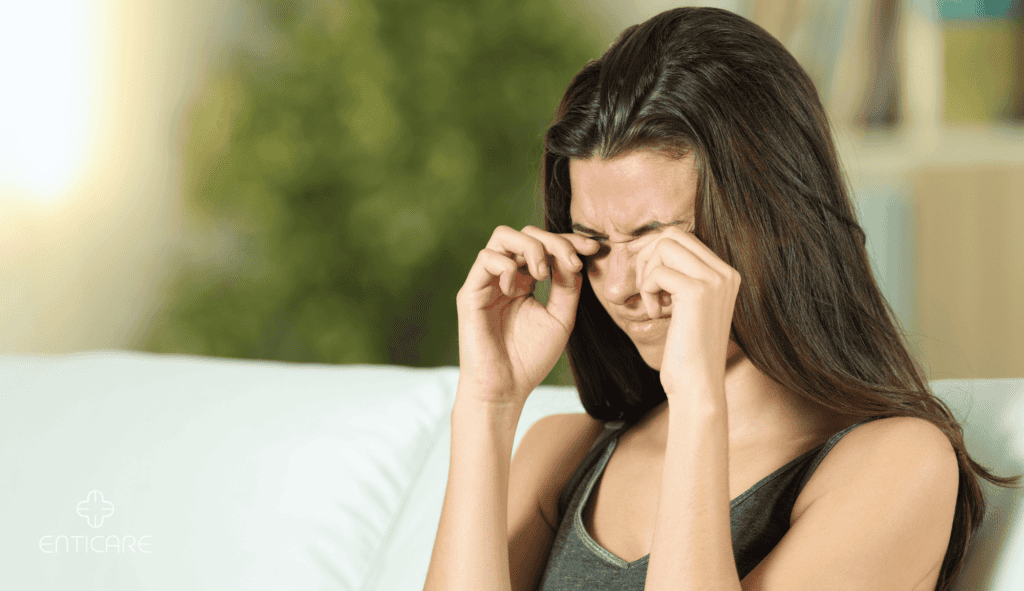As summer’s heat fades, the arrival of autumn often brings relief from sweltering days and a burst of beautiful colors. But for many, fall also signals the start of the fall allergy season, with sneezing, itchy eyes, and congestion. Understanding how fall allergies work can help you manage symptoms and enjoy this season fully. Let’s dive into the causes, symptoms, treatments, and ways to keep your allergies in check.

Fall Allergies: Why They Happen
Ragweed Pollen
Ragweed is one of the biggest contributors to fall allergies. It begins releasing pollen in late summer and can persist until the first frost. A single ragweed plant can produce up to a billion pollen grains, which easily spread through the air, triggering allergy symptoms in sensitive individuals.
Mold Growth
Fallen leaves create piles that accumulate moisture, a perfect environment for mold growth. Damp and decomposing leaves can harbor mold spores, leading to leaf mold allergies in sensitive individuals. This type of mold can be especially troublesome as it continues growing in warmer indoor spaces.
Dust Mites Indoors
With cooler weather, people spend more time indoors. Heating systems get turned on, disturbing settled dust and circulating it throughout homes. Dust mites in household dust can trigger allergies for those who are sensitive.
Quick Tip: To limit exposure to these allergens, consider keeping windows closed, using air purifiers, and washing bedding regularly.

Recognizing Fall Allergy Symptoms
Respiratory Symptoms
Typical symptoms include sneezing, congestion, and a runny nose. Many people experience these symptoms primarily in the morning when pollen counts tend to be highest.
Eye Irritation
Watery, itchy, and red eyes are common during fall, as allergens easily reach the eyes, irritating sensitive membranes.
Fatigue and Sinus Pressure
Constant exposure to allergens can lead to inflammation, causing sinus headaches and a feeling of fatigue or lethargy. Severe allergies can even disrupt sleep, leading to increased daytime tiredness.
Did You Know? Some fall allergy symptoms may resemble cold symptoms, but allergies don’t include fever and usually last as long as the allergen remains in the environment.
Effective Treatments for Fall Allergies
Over-the-Counter Options
Antihistamines, decongestants, and nasal sprays can offer relief. Antihistamines, like cetirizine or loratadine, block histamines that cause itchy eyes and sneezing, while decongestants reduce nasal inflammation.
Allergy Shots (Immunotherapy)
For severe allergies, immunotherapy can be highly effective. Allergy shots expose the immune system to small, controlled amounts of allergens, reducing sensitivity over time and offering long-term relief.
Nasal Irrigation
Using a saline rinse or neti pot flushes out allergens trapped in the nasal passages, reducing congestion and inflammation. A daily rinse can make a noticeable difference during peak allergy season.
Tip: Talk to your doctor before starting any new allergy medication, especially if you’re currently on prescription medications.
Preventative Measures to Limit Exposure
Stay Informed on Pollen Counts
Check your local pollen count daily and try to avoid outdoor activities on high-pollen days, especially in the early morning when pollen is often at its peak.
Create a Barrier with Clothing
When spending time outdoors, wear sunglasses to reduce pollen contact with your eyes, and consider a hat to prevent pollen from settling in your hair.
Clean Your Living Space Regularly
Dust and vacuum frequently, and change air filters in your home. Consider using a HEPA filter to capture more airborne allergens effectively.
Pro Tip: Try to shower and change clothes immediately after being outdoors. Pollen can stick to your clothes, hair, and skin, increasing your exposure.
When to Seek Professional Help for Fall Allergies
Persistent Symptoms Despite Treatment
If you’ve tried over-the-counter medications but still experience ongoing symptoms, consulting with a healthcare provider may help determine additional options or rule out other conditions.
Difficulty Breathing or Chest Tightness
Severe allergies can sometimes lead to asthma symptoms. Breathing difficulties, wheezing, and chest tightness may indicate that allergies are affecting your respiratory health, requiring medical assessment.
Frequent Sinus Infections
Chronic nasal congestion can lead to sinus infections. If you experience sinus infections frequently during allergy season, this could be a sign that your allergies need a more targeted treatment plan.
Did You Know? Consulting an ENT specialist can help determine if allergies are impacting your sinuses or respiratory health and if additional treatments, like allergy shots or specialized medications, may be right for you.

Long-term Effects of Fall Allergies
Fall allergies can have long-term effects on your health if left untreated or poorly managed. Here are some potential long-term effects to be aware of:
-
- Chronic Congestion: Repeated exposure to allergens can lead to chronic congestion, which can cause sinus infections, ear infections, and other respiratory problems.
- Asthma: Fall allergies can trigger asthma attacks, leading to chronic inflammation and scarring in the lungs. Managing your allergies can help prevent these severe respiratory issues.
- Allergic Rhinitis: Fall allergies can cause allergic rhinitis, a condition characterized by chronic inflammation and congestion in the nasal passages. This can significantly impact your quality of life if not properly managed.
- Weakened Immune System: Repeated exposure to allergens can weaken your immune system, making you more susceptible to illnesses and infections. Keeping your allergies in check is crucial for maintaining overall health.
It’s essential to take fall allergies seriously and seek medical attention if your symptoms persist or worsen over time.
Don’t Let Fall Allergies Hold You Back
Fall allergies can disrupt your life, but understanding their triggers and taking proactive steps can minimize symptoms. From staying informed about pollen counts to managing your environment, taking control of your allergies will allow you to enjoy autumn’s beauty without the discomfort. If fall allergies continue to bother you despite at-home treatments, speaking with an allergy specialist can make a world of difference.
Are you ready to tackle your fall allergies head-on? Schedule an appointment with our specialists today to explore customized allergy treatments that work for you. Click here to schedule your appointment.
Conclusion
Fall allergies can be a significant issue for many people, especially those who enjoy spending time outdoors during the autumn season. The combination of mold spores, ragweed pollen, and other fall allergy triggers can cause a range of symptoms, including runny nose, sneezing, itchy eyes, and congestion. To manage these symptoms, it’s essential to understand the causes of fall allergies and take steps to prevent inhaling mold spores and other allergens.
One of the most effective ways to prevent fall allergies is to limit exposure to fallen leaves, which can harbor mold spores. This can be done by wearing protective gear, such as a mask and gloves, when raking leaves or engaging in other outdoor activities. Additionally, showering and changing clothes after spending time outdoors can help reduce exposure to mold spores and other allergens.
For those who experience severe fall allergy symptoms, prescription medications and immunotherapy may be necessary. These treatments can help alleviate symptoms and prevent future allergic reactions. It’s also important to note that fall allergies can be mistaken for colds and the flu, making it essential to consult a healthcare provider to determine the best course of treatment.
In conclusion, fall allergies are a common issue that can be managed with the right knowledge and precautions. By understanding the causes of fall allergies and taking steps to prevent exposure to mold spores and other allergens, individuals can enjoy the autumn season without suffering from allergic symptoms.

